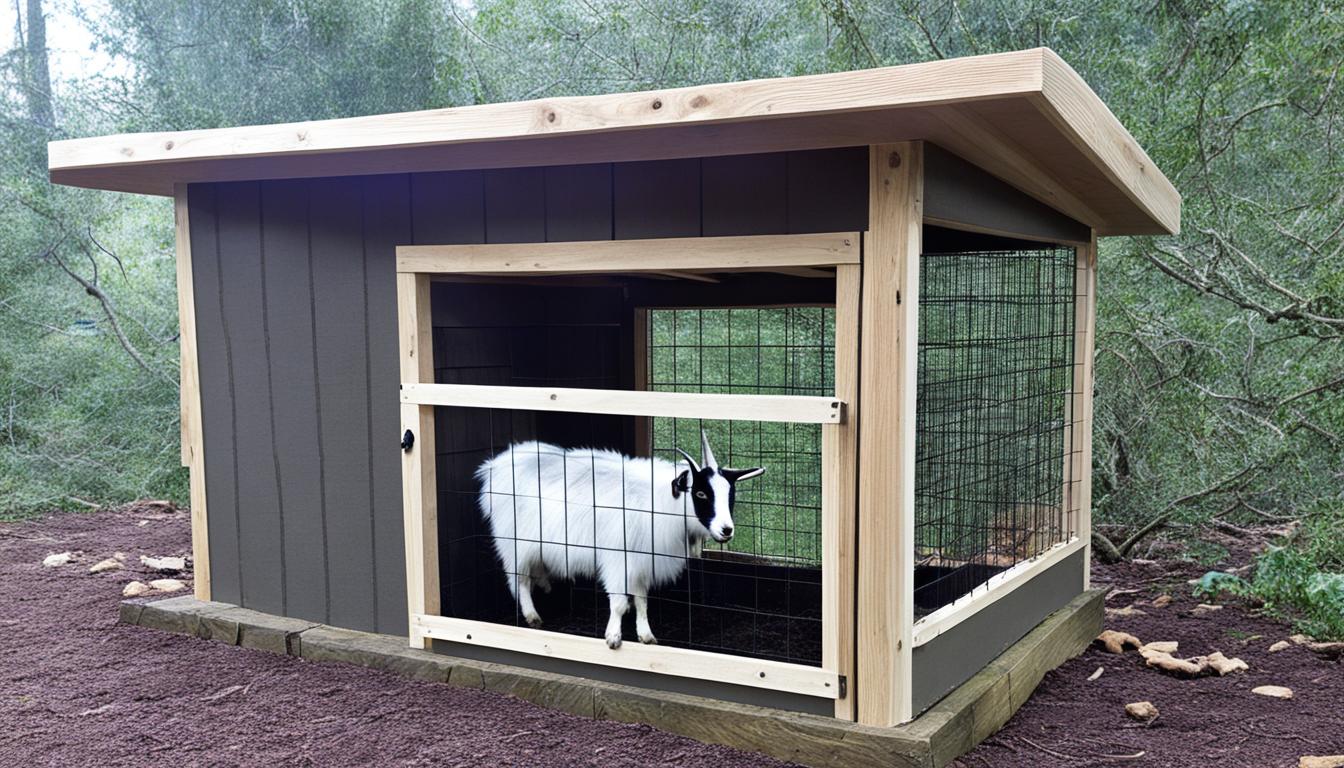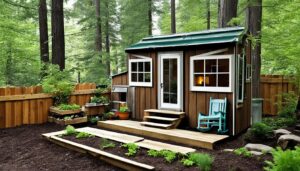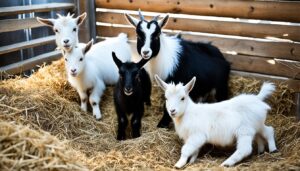I loved petting my pygmy goats. Their shelter seemed snug, but was it enough? These sweet creatures are my joy. I want to make sure they’re both healthy and happy. So, here’s a detailed guide to help you. It will show you how to make a great home for your pygmy goats.
Figuring out the right size and needs for a pygmy goat house matters a lot. We will talk about everything you need to know. From how much space per goat to the air inside and the ground they walk on. And we’ll also cover how to deal with the special needs of a pygmy goat group. After reading this, you’ll know exactly what your pygmy goats need for a happy, healthy home.
Key Takeaways
- Pygmy goats need at least 16 sq. ft. (1.5 m²) each indoors for rest. They also need 25-50 sq. ft. (2.3-4.6 m²) for play space.
- Make sure your goats have dry spots for lying down and eating areas without competition. Plus, they need room for play.
- Ideally, a barn should have 21-32 sq. ft. (2-3 m²) for each goat. Does that are pregnant or kids need more room.
- Foraging goats need an acre for one to three of them (3-9 goats/hectare). Keep in mind how much they eat and that the grass needs to grow back.
- Using partitions and platforms in the barn can cut down on the space each goat needs. It can also help keep the peace.
Understanding Pygmy Goats’ Housing Needs
Pygmy goats’ health and happiness depend a lot on where they live. It’s critical to meet their goats’ space needs and pygmy goat housing requirements. We must focus on how goat health and welfare in housing impact them. The importance of environment for pygmy goats is vital for their well-being.
Goats’ Health and Welfare Requirements
Goats love to rest and eat peacefully. They need dry spots to lie and stretch. Places to eat not having a lot of competition is important. If their area is always damp or not aired well, they can get sick.
Importance of Adequate Space and Environment
Goats are active and love to explore. They need a lot of room to play and something new to see every day. It’s key to their health and behavior. When thinking about the perfect home for pygmy goats, keep factors affecting goat space needs in mind.
Space Requirements in the Barn
Housing pygmy goats correctly is vital for their happiness and health. The indoor space requirements for pygmy goats differ based on your herd’s needs.
Recommended Space Allowances for Does
For does, giving them a place to rest comfortably inside the barn means about 16 sq. ft. (1.5 m²) each. They also need 25–50 sq. ft. (2.3–4.6 m²) more for an activity area. This lets does move freely and act naturally. Younger goats may need less, and bucks might need a little more space.
Space Needs for Bucks and Kids
Bucks need between 16 and 32 sq. ft. (1.5–3 m²) because they’re bigger and more active. Kids need space to play and grow but usually don’t need as much room as adults. It’s crucial to ensure they still have plenty of room to explore.
Deciding on a recommended barn size for pygmy goats means considering how many goats you have. This ensures they have enough space for a happy and healthy life in the barn.

Pasture and Outdoor Space
Pygmy goats are lively and love to explore. They need a large outdoor area to graze and play. Having a big space is as crucial as a cozy indoor spot for their health and happiness.
Land Area for Sustainable Grazing
For 70% of their food needs, pygmy goats require about an acre for every one to three of them (3–9 goats per hectare). The space needed depends on how much food the land produces. This varies with soil type, the weather, the time of year, and how long the grass is. If you don’t have a lot of land, you might have to add hay to their diet. This makes sure each goat gets the right amount of food daily, 4.4–7.7 lb. (2–3.5 kg) of dry matter.
Importance of Rotation and Regrowth
Managing their outdoor area well keeps their pasture healthy. Too many goats in one spot can hurt the grass and cause sickness because the grass doesn’t have time to grow back. By using a rotation system, plants in the pasture can grow again. This means a continuous supply of healthy food for your goats.
What Size Should a Pygmy Goat House Be?
Studies show that minimum indoor space per goat is crucial. For example, dairy does from Norway were happier when they had more space. They did best with 32 sq. ft. (3 m²) each during pregnancy. This helped them avoid being too close to others.
The pregnant goats liked even more room as time went on. They showed they needed 21–32 sq. ft. (2–3 m²). Thus, this area is good for a goat to be comfortable during pregnancy.
But, we must remember, factors that affect pygmy goat housing space needs go beyond the basics. The size of the group, if there are kids, and the gender of the goats matter too. Keeping these things in mind makes sure your goats have what they need to be happy.

Designing a Comfortable Goat Shelter
Creating the perfect home for your pygmy goats needs focus on ventilation and flooring. Good air flow keeps their space healthy. And the right flooring helps them feel cozy and stays clean.
Ventilation and Flooring Considerations
It’s vital to have good air movement in your goat’s house, no matter how many you have. I suggest a solid door design that can be partly closed with a hook. This helps control airflow. Windows at the building’s back, made of perspex, ensure there’s enough fresh air. Remember to avoid strong north winds in the placement of your goat’s home.
Bedding Options for Warmth and Hygiene
Choosing the best bedding impacts your goats’ well-being. Use materials like straw or wood shavings for warmth and cleanliness. A soft, dry bed is crucial for keeping your goats happy and preventing sickness. Change and maintain the bedding often to stop odor and health problems.

Keep these points in mind when designing your goat shelter. This will make a space that’s both comfy and meets your pygmy goats’ needs.
Feeding Area and Water Accessibility
Feeding and water access are key for your pygmy goats’ health. It’s crucial to pick the right space and size for their feeding area. Hayracks must be safe, with lids to stop kids from harm. They should be at a good height for all goats. Consider using movable racks too.
Hay Rack Dimensions and Placement
Make sure young pygmy goats can get hay from the bottom, and adults can reach the top easily. Adding mesh can cut down on wasted hay. Moveable racks work well, especially with hurdles for separating goats.
Providing Clean Water Sources
Having clean water for your goats is vital. You must clean and refill their water often to keep them healthy. Since goats are playful, secure the water containers well to avoid spills and keep the water pure.

Fencing and Enclosure Requirements
Keeping your pygmy goats safe means having a strong and well-built enclosure. This enclosure keeps your goats from getting out and getting hurt. Choosing the right fencing materials and the right height helps to stop your goats from wandering away and prevents accidents.
Fencing Materials and Height
It’s very important to fence off the area your goats will roam, no matter how much land you have. Make sure there’s no barbed wire anywhere in your fence. Stock fencing is a popular choice along with post and rail. The fencing must be pulled tight and should not leave any gaps at the bottom. If it’s not tight, goats, especially the young ones, might find a way out. Adding a wooden rail on top of the stock wire helps but can be a problem for goats with horns. Chain link is a good option, but it can be costly. For the best solution, many recommend strong, weld mesh fencing with post and rail. No matter the type, the fence must be tight with no spaces for goats to sneak through.
Preventing Escapes and Entanglement
Making sure your pygmy goats can’t get out or get stuck is key. Good fencing for pygmy goats is usually 4 to 5 feet tall. This height keeps them safe and secure. Also, there should be no big gaps they could slip through. The material of the fence should be strong and close-woven to keep your goats in. Always check the fence for any damage or weak points. This helps you ensure the goats’ home is always safe.

Accommodating Herd Dynamics
Managing a pygmy goat herd means understanding the herd’s unique dynamics. It’s crucial to keep bucks and does apart to avoid chaos and unplanned breeding. Creating separate areas ensures the herd’s needs are carefully managed.
Separating Bucks and Does
Keeping a group of pet goats requires separating the males from the females initially. This separation period allows them to get used to each other. Portable hurdles are great for this, helping you divide their living spaces.
Providing Individual Spaces for Conflict Resolution
In a herd, it’s vital to offer individual spaces for each goat. This gives goats a private place to relax, eat, and socialize, reducing conflicts. Personal spaces help meet the different needs of each goat, leading to a friendly living space.

Hard Standing and Outdoor Access
Hard standing and a lot of outdoor access are key in pygmy goat housing. Sadly, most goat homes miss enough hard standing. It’s often the part that’s forgotten. All the moving in and out makes the area very muddy.
Importance of Dry Outdoor Areas
Pygmy goats love to play outside, and this is very important in winter. They need dry outdoor areas to stay healthy and happy. Not having enough hard ground can hurt their feet, causing problems like foot rot.
Movable Shelters and Play Structures
For outdoor access and play, you can add things like movable benches and hayracks. These also stop the goats from sinking in the mud. Being creative with your outdoor area can make it a fun and safe place for your goats.

Customizing and Adapting Existing Spaces
Having a big outbuilding for your pygmy goats is a plus. It lets you change and adapt it to their needs. Hurdles have been a great help for me. They help me make different-sized pens for goats, either alone or in a group.
Utilizing Partitions and Hurdles
Hurdles make a big difference in making spaces work for pygmy goats. They let you try many setups to see what fits your goats best. It’s smart to try different pen sizes because how the goats get along changes. Kids grow up, and suddenly, the barn feels too small for that family.
Maximizing Limited Space Creatively
With a smaller area, you can still make a great goat shelter. I’ve used partitions and hurdles strategically to divide the space. It gives each goat their own spot while keeping the area together. This approach helps with managing the goats’ dynamics and changing their space as they grow.
FAQ
What is the recommended indoor space per pygmy goat?
You should have about 16 sq. ft. (1.5 m²) for each doe in the barn. For their activity space, they need 25–50 sq. ft. (2.3–4.6 m²) each. Bucks need more space, while young goats need less.
How much outdoor space do pygmy goats need?
For three pygmy goats, aim for at least an acre. This ensures that 70% of their food is from forage. The space required will vary based on pasture yield.
What are some important ventilation and flooring considerations for a pygmy goat house?
Ventilation is key, use stable doors and small windows. This allows for fresh air without drafts. Also, ensure the ground outside stays dry.
How should the feeding area and water sources be set up for pygmy goats?
Hay should be in racks off the ground. Make sure it’s easy for goats to eat without hurting themselves. Multiple food places help avoid conflicts, as does having clean water available.
What fencing and enclosure requirements should be considered for pygmy goats?
Choose safe fencing like stock fencing and avoid barbed wire. The fencing needs to be strong to keep the goats in, especially young ones with horns.
How can I accommodate the herd dynamics and individual needs of my pygmy goats?
Keep bucks and does apart, and allow for personal space within their housing. Watching how the goats interact can help you change their surroundings if needed.
What are some tips for customizing and adapting existing spaces for pygmy goat housing?
Partition larger areas to provide separate spaces. If space is limited, use movable shelters and outdoor spots for play and stay dry.



